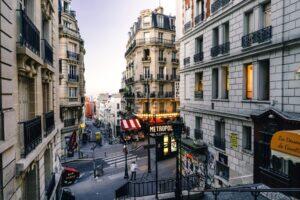Fodor's Expert Review Place de la Bastille
Almost nothing remains of the infamous Bastille prison, destroyed more than 225 years ago, though tourists still ask bemused Parisians where to find it. Until the late 1980s, there was little more to see here than a busy traffic circle ringing the Colonne de Juillet (July Column), a memorial to the victims of later uprisings in 1830 and 1848. The opening of the Opéra Bastille in 1989 rejuvenated the area, however, drawing art galleries, bars, and restaurants to the narrow streets, notably along Rue de Lappe—once a haunt of Edith Piaf—and Rue de la Roquette.
Before it became a prison, the Bastille St-Antoine was a defensive fortress with eight immense towers and a wide moat. It was built by Charles V in the late 14th century and transformed into a prison during the reign of Louis XIII (1610–43). Famous occupants included Voltaire, the Marquis de Sade, and the Man in the Iron Mask. On July 14, 1789, it was stormed by an angry mob that dramatically freed all... READ MORE
Almost nothing remains of the infamous Bastille prison, destroyed more than 225 years ago, though tourists still ask bemused Parisians where to find it. Until the late 1980s, there was little more to see here than a busy traffic circle ringing the Colonne de Juillet (July Column), a memorial to the victims of later uprisings in 1830 and 1848. The opening of the Opéra Bastille in 1989 rejuvenated the area, however, drawing art galleries, bars, and restaurants to the narrow streets, notably along Rue de Lappe—once a haunt of Edith Piaf—and Rue de la Roquette.
Before it became a prison, the Bastille St-Antoine was a defensive fortress with eight immense towers and a wide moat. It was built by Charles V in the late 14th century and transformed into a prison during the reign of Louis XIII (1610–43). Famous occupants included Voltaire, the Marquis de Sade, and the Man in the Iron Mask. On July 14, 1789, it was stormed by an angry mob that dramatically freed all of the remaining prisoners (there were only seven), thereby launching the French Revolution. The roots of the revolt ran deep. Resentment toward Louis XVI and Marie-Antoinette had been building amid a severe financial crisis. There was a crippling bread shortage, and the free-spending monarch was blamed. When the king dismissed the popular finance minister, Jacques Necker, enraged Parisians took to the streets. They marched to Les Invalides, helping themselves to stocks of arms, then continued on to the Bastille. A few months later, what was left of the prison was razed—and 83 of its stones were carved into miniature Bastilles and sent to the provinces as a memento (you can see one of them in the Musée Carnavalet). The key to the prison was given to George Washington by Lafayette and has remained at Mount Vernon ever since. Today, nearly every major street demonstration in Paris—and there are many—passes through this square.
READ LESS








